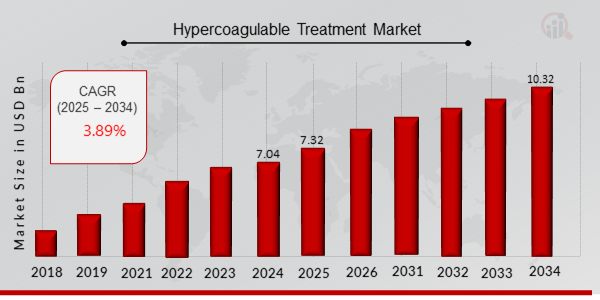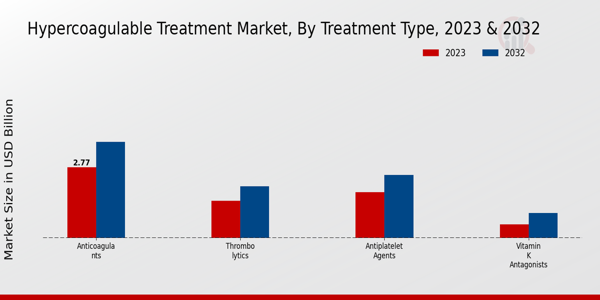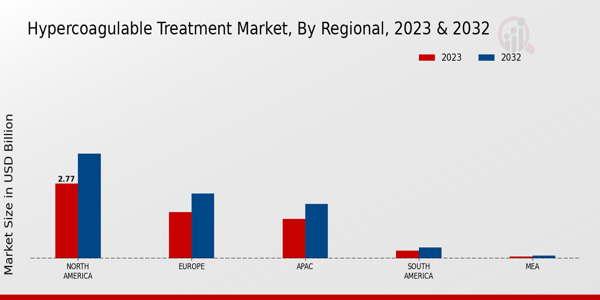Hypercoagulable Treatment Market Overview
As per MRFR analysis, the Hypercoagulable Treatment Market Size was estimated at 7.04 (USD Billion) in 2024. The Hypercoagulable Treatment Market Industry is expected to grow from 7.32 (USD Billion) in 2025 to 10.32 (USD Billion) till 2034, at a CAGR (growth rate) is expected to be around 3.89% during the forecast period (2025 - 2034).
Key Hypercoagulable Treatment Market Trends Highlighted
The Hypercoagulable Treatment Market is increasingly driven by the rising prevalence of clotting disorders and related cardiovascular diseases. An aging population and lifestyle factors, such as obesity and sedentary habits, contribute significantly to the growing incidence of conditions requiring hypercoagulable treatments. Increased awareness regarding the importance of early diagnosis and effective management of clotting disorders has spurred the adoption of advanced therapeutic options. Research and development efforts focused on creating novel anticoagulant medications and personalized treatment plans also play a crucial role in market expansion. Potential opportunities lie in the rising demand for innovative therapies and the development of point-of-care diagnostic tools. Companies can capitalize on these opportunities by exploring partnerships and collaborations to enhance their product offerings and reach underserved markets. Additionally, the integration of technology in monitoring and management systems presents a pathway for improved patient care and adherence to treatment regimens. Recent trends indicate a shift towards a more patient-centric approach in treatment strategies, focusing on individualized therapies and precision medicine. The growing emphasis on managing risk factors and optimizing treatment plans for specific patient populations reflects the ongoing evolution of the healthcare landscape.Furthermore, there is an increasing integration of digital health solutions that facilitate remote monitoring and telehealth consultations. These trends indicate a broader movement towards more accessible and efficient treatment options, essential for meeting the needs of a diverse patient population. Overall, the market is poised for growth as it adapts to these evolving demands and explores new avenues for innovation.

Source: Primary Research, Secondary Research, MRFR Database and Analyst Review
Hypercoagulable Treatment Market Drivers
Increasing Incidence of Thromboembolic Disorders
The Hypercoagulable Treatment Market Industry is significantly driven by the rising incidence of thromboembolic disorders, which include conditions such as deep vein thrombosis, pulmonary embolism, and other related ailments. As populations age, the prevalence of chronic diseases that lead to hypercoagulability increases, creating a larger patient base that requires effective treatment solutions. Furthermore, lifestyle changes, including sedentary behaviors and obesity, are contributing to a higher rate of these disorders.Increasing awareness and diagnosis of these conditions are also factors that enhance the market growth, as more patients are being treated than ever before. As the healthcare systems continue to innovate and improve diagnostic technologies, the rates of detection and treatment are expected to rise, leading to a substantial expansion in the Hypercoagulable Treatment Market Industry. With advances in laboratory testing and screening methods, healthcare providers are now more adept at identifying patients at risk, allowing for early intervention and management of thromboembolic events.Additionally, ongoing research and development in pharmacological treatments are continuously broadening the scope of available therapies, catering to diverse patient needs and varying underlying conditions. The combination of increasingly diagnosed cases and the availability of new treatment options drives the demand for hypercoagulable therapies, indicating a promising outlook for growth in the market.
Advancements in Treatment Options
Rapid advancements in treatment options are another critical driver of the Hypercoagulable Treatment Market Industry. The pharmaceutical sector is seeing the introduction of innovative anticoagulants and antithrombotic drugs that offer improved efficacy and safety profiles over traditional therapies. The development of targeted therapies is addressing specific risk factors associated with hypercoagulable states, providing healthcare professionals with tailored treatment protocols.Ongoing clinical trials and research are continuously contributing to a deeper understanding of coagulation pathways, which supports the emergence of new and more effective treatment modalities. These advancements not only improve patient outcomes but also expand the overall market as more treatment options become available.
Growing Awareness Among Healthcare Providers and Patients
The growing awareness among healthcare providers and patients regarding the risks associated with hypercoagulability is a substantial driver for the Hypercoagulable Treatment Market Industry. Educational initiatives and targeted campaigns are enhancing knowledge about the dangers of not addressing hypercoagulable conditions, thus encouraging proactive healthcare behavior. Increased understanding of symptom identification and risk factors leads to faster diagnosis and treatment initiation, ultimately improving patient outcomes and stimulating market demand.
Hypercoagulable Treatment Market Segment Insights
Hypercoagulable Treatment Market Treatment Type Insights
The Hypercoagulable Treatment Market, valued at 6.52 USD Billion in 2023, is significantly shaped by its segmentation into various Treatment Types, each catering to specific therapeutic needs in managing hypercoagulable states. Anticoagulants stand out as a crucial segment, holding a market valuation of 2.77 USD Billion in 2023 and expected to rise to 3.76 USD Billion by 2032, demonstrating their majority holding in the market due to their primary role in preventing blood clot formation, which is vital for patients at risk of thromboembolic events.Following this, the Thrombolytics segment is valued at 1.45 USD Billion in 2023, anticipated to grow to 2.01 USD Billion by 2032. This reflects the importance of thrombolytics in the rapid dissolution of clots, particularly in acute scenarios, making them significant in critical care. Antiplatelet Agents also play an essential role, with a market value of 1.78 USD Billion in 2023, projected to increase to 2.46 USD Billion by 2032, as they are increasingly utilized for long-term management of cardiovascular diseases, showing their growing relevance in the prevention of secondary thrombotic events.Lastly, Vitamin K Antagonists, although the smallest in terms of market share, valued at 0.52 USD Billion in 2023 and expected to reach 0.97 USD Billion in 2032, still represent a crucial treatment avenue, particularly for managing anticoagulation in specific patient populations. The segmentation showcases the diverse approaches to treatment in the Hypercoagulable Treatment Market, reflecting ongoing advancements in therapeutic agents, increased awareness of hypercoagulable conditions, and the pressing need for tailored treatment strategies.This market's growth is driven by rising incidence rates of thrombotic disorders, an aging population, and ongoing innovations in drug formulations and delivery methods that enhance efficacy and safety profiles across these treatment types.

Source: Primary Research, Secondary Research, MRFR Database and Analyst Review
Hypercoagulable Treatment Market Route of Administration Insights
The Hypercoagulable Treatment Market, valued at 6.52 billion USD in 2023, showcases a significant focus on the Route of Administration, which plays a crucial role in treatment efficacy and patient compliance. This segment is characterized by various methods including Oral, Injectable, and Intravenous administration, each catering to distinct patient needs. Oral administration remains notable due to its ease of use and patient preference, leading to greater market acceptance. Injectable routes are essential in acute care settings, ensuring rapid therapeutic effects in critical scenarios.Meanwhile, Intravenous administration dominates in hospitals for immediate drug delivery, providing high bioavailability and precision. The ongoing advancements in formulation technologies further enhance the effectiveness and convenience of these delivery methods, driving the overall market growth. Factors such as increasing prevalence of thromboembolic disorders, along with rising awareness and accessibility to treatment options, are fueling the demand across these routes, aligning well with the Hypercoagulable Treatment Market segmentation insights.As this market evolves, it presents notable opportunities, particularly to innovate delivery systems that enhance patient convenience and adherence, ultimately impacting treatment outcomes positively.
Hypercoagulable Treatment Market Condition Indicated Insights
The Hypercoagulable Treatment Market, valued at 6.52 USD Billion in 2023, is showing promising growth, highlighting the growing prevalence of conditions such as Deep Vein Thrombosis, Pulmonary Embolism, Atrial Fibrillation, and Stroke. These conditions collectively dominate the Hypercoagulable Treatment Market revenue, with significant attention aimed at developing efficient treatment options. Deep Vein Thrombosis is critical due to its high incidence and potential for severe complications, thereby establishing itself as a central focus.Pulmonary Embolism remains a major concern since it can lead to life-threatening outcomes, driving continuous innovation in treatment methods. Atrial Fibrillation is important within the market, as it is linked to an increased risk of stroke, prompting ongoing advancements and therapies to manage this risk effectively. Stroke remains a leading cause of mortality and long-term disability worldwide, further underscoring the necessity for targeted treatments. Overall, the Hypercoagulable Treatment Market industry is characterized by robust market growth, driven by rising awareness, advanced healthcare infrastructures, and increased investments in research, although challenges like compliance and healthcare costs persist.The segmentation of this market reflects the diverse needs stemming from various coagulation disorders, emphasizing tailored approaches in treatment methodologies to ensure effective patient outcomes.
Hypercoagulable Treatment Market End User Insights
The Hypercoagulable Treatment Market is projected to value at 6.52 USD Billion in 2023, showcasing significant growth potential in the End User segment, which includes Hospitals, Specialty Clinics, and Home Care Settings. Hospitals dominate this market, primarily due to their centralized resources and extensive patient outreach. Specialty Clinics are also pivotal as they provide focused treatment solutions and advanced care for hypercoagulable conditions, catering to patients with specific needs. Home Care Settings are becoming increasingly significant as they offer personalized care options, allowing patients to receive treatment in a familiar environment,, which enhances patient comfort and compliance.The overall market is driven by factors such as the rising incidence of thromboembolic disorders and the growing awareness of hypercoagulability. However, challenges like a lack of awareness and issues surrounding accessibility may impede growth. Opportunities abound in technology and telehealth solutions, particularly for Home Care Settings, allowing better management of patients remotely. The market is expected to grow steadily, presenting various pathways for innovation and improved patient outcomes in the Hypercoagulable Treatment Market industry.
Hypercoagulable Treatment Market Regional Insights
The Hypercoagulable Treatment Market revenue in 2023 is valued at 6.52 USD Billion, showcasing a diverse geographical segmentation. North America holds a significant position within the market, with a valuation of 2.77 USD Billion, projected to grow to 3.87 USD Billion by 2032, thus dominating the region due to advanced healthcare infrastructure and high disease prevalence. Europe follows closely, valued at 1.72 USD Billion in 2023 and expected to reach 2.4 USD Billion by 2032, indicating strong healthcare policies and increasing awareness.Meanwhile, APAC has been growing steadily, with a valuation of 1.47 USD Billion in 2023, which may rise to 2.02 USD Billion by 2032, driven by improving healthcare access and rising chronic disease rates. South America, at 0.29 USD Billion in 2023 and anticipated 0.41 USD Billion by 2032, represents emerging opportunities although it remains relatively smaller due to economic challenges. The MEA region, valued at 0.07 USD Billion, is the least significant in this market yet shows potential due to increasing healthcare investments. Overall, the Hypercoagulable Treatment Market statistics highlight varying regional growth dynamics influenced by healthcare systems, disease prevalence, and population health trends.

Source: Primary Research, Secondary Research, MRFR Database and Analyst Review
Hypercoagulable Treatment Market Key Players and Competitive Insights
The Hypercoagulable Treatment Market has garnered increasing attention due to the rising prevalence of hypercoagulable states, which can lead to severe complications such as thrombosis. This market is characterized by a diverse array of treatment options that encompass anticoagulants, antiplatelet agents, and thrombolytics, attracting a myriad of pharmaceutical companies seeking to position themselves competitively. The key players in this market strive to innovate and expand their product portfolios through research and development, acquisitions, and strategic partnerships, aiming to enhance patient outcomes and address the unmet medical needs associated with hypercoagulable conditions. The competitive landscape is further influenced by healthcare regulations, patent expirations, and the demand for personalized medicine, driving the need for companies to remain agile in their strategies while effectively navigating the complexities of global healthcare demands.Pfizer holds a significant position in the Hypercoagulable Treatment Market, showcasing its strength through a robust portfolio that includes well-established anticoagulant therapies. The company's extensive research capabilities enable it to continuously advance its offerings, ensuring that its products remain effective and meet the evolving needs of healthcare providers and patients. Pfizer's global presence allows it to leverage its vast distribution network, ensuring accessibility to its treatments across various markets. This reach not only enhances its market share but also fosters strong relationships with healthcare professionals, thereby positioning Pfizer as a trusted entity in hypercoagulable treatment solutions. Moreover, Pfizer's commitment to safety and efficacy in its product offerings reinforces its reputation among consumers and practitioners alike, making it a formidable player in this competitive market.Roche, another key player in the Hypercoagulable Treatment Market, is recognized for its innovative approach to treatment and strong emphasis on research and development. The company is deeply invested in understanding the mechanisms underlying hypercoagulable states, which informs its product development strategies and fosters the creation of targeted therapies. Roche's established reputation in the biotechnology sector plays a crucial role in instilling confidence among healthcare providers regarding the efficacy and safety of its treatments. By leveraging its advanced diagnostic capabilities, Roche aims to enhance patient management in hypercoagulable conditions through precision medicine. Furthermore, Roche's strategic partnerships and collaborations with academic institutions and research organizations further bolster its innovative pipeline, allowing it to remain competitive in a rapidly evolving market landscape. As the demand for effective treatment solutions expands, Roche's continual focus on advancing therapeutic options positions the company as a key contributor to the evolving dynamics of the hypercoagulable treatment market.
Key Companies in the Hypercoagulable Treatment Market Include
- Pfizer
- Roche
- Bayer
- Eli Lilly
- Bristol Myers Squibb
- Regeneron Pharmaceuticals
- Johnson and Johnson
- Servier
- AstraZeneca
- Amgen
- AbbVie
- GSK
- Merck and Co
- Novartis
- Sanofi
Hypercoagulable Treatment Market Industry Developments
The Hypercoagulable Treatment Market has seen significant activity recently, with companies like Pfizer, Roche, and Bayer taking strides in their respective therapeutic developments. Eli Lilly has expanded its clinical trials on anticoagulants, aiming to enhance treatment efficacy and safety. Bristol Myers Squibb is focusing on innovative drug formulations to address unmet needs in hypercoagulable conditions. Significant collaborations have emerged, such as Regeneron Pharmaceuticals partnering with Johnson and Johnson for joint research on hypercoagulability's genetic aspects. Sanofi and GSK also reported joint efforts to develop novel anticoagulant strategies. In the realm of mergers and acquisitions, Amgen's acquisition of a niche biotech firm specializing in hypercoagulable disorders was widely discussed, as was AbbVie's recent investment in expanding its cardiovascular portfolio. Additionally, growth in market valuation for companies like AstraZeneca and Merck and Co is noted, as their aggressive R&D pathways are likely positioning them for larger market shares. As the hypercoagulable treatment landscape evolves, these developments indicate a robust response to the increasing prevalence of thrombotic disorders and a competitive environment for market participants.
Hypercoagulable Treatment Market Segmentation Insights
- Hypercoagulable Treatment Market Treatment Type Outlook
- Anticoagulants
- Thrombolytics
- Antiplatelet Agents
- Vitamin K Antagonists
- Hypercoagulable Treatment Market Route of Administration Outlook
- Oral
- Injectable
- Intravenous
- Hypercoagulable Treatment Market Condition Indicated Outlook
- Deep Vein Thrombosis
- Pulmonary Embolism
- Atrial Fibrillation
- Stroke
- Hypercoagulable Treatment Market End User Outlook
- Hospitals
- Specialty Clinics
- Home Care Settings
- Hypercoagulable Treatment Market Regional Outlook
- North America
- Europe
- South America
- Asia Pacific
- Middle East and Africa
| Report Attribute/Metric |
Details |
|
Market Size 2024
|
7.04 (USD Billion)
|
|
Market Size 2025
|
7.32 (USD Billion)
|
|
Market Size 2034
|
10.32 (USD Billion)
|
|
Compound Annual Growth Rate (CAGR)
|
3.89% (2025 - 2034)
|
|
Report Coverage
|
Revenue Forecast, Competitive Landscape, Growth Factors, and Trends
|
|
Base Year
|
2024
|
|
Market Forecast Period
|
2025 - 2034
|
|
Historical Data
|
2020 - 2024
|
| Market Forecast Units |
USD Billion |
| Key Companies Profiled |
Pfizer, Roche, Bayer, Eli Lilly, Bristol Myers Squibb, Regeneron Pharmaceuticals, Johnson and Johnson, Servier, AstraZeneca, Amgen, AbbVie, GSK, Merck and Co, Novartis, Sanofi |
| Segments Covered |
Treatment Type, Route of Administration, Condition Indicated, End User, Regional |
| Key Market Opportunities |
Rising prevalence of clotting disorders, Innovative drug development and therapies, Growth in diagnostic technologies, Increasing awareness and education programs, Expanding telemedicine for patient management |
| Key Market Dynamics |
Rising prevalence of thrombosis , Advancements in treatment technologies , Increasing awareness and diagnosis , Growing geriatric population , Expanding pipeline of therapies |
| Countries Covered |
North America, Europe, APAC, South America, MEA |
Frequently Asked Questions (FAQ) :
The Hypercoagulable Treatment Market is expected to be valued at 10.32 USD Billion by 2034.
The market is projected to have a CAGR of 3.89% from 2025 to 2034.
North America is expected to hold the largest market share, projected to reach 3.87 USD Billion by 2032.
The market value for Anticoagulants is expected to reach 3.76 USD Billion by 2032.
Major players include Pfizer, Roche, Bayer, Eli Lilly, and Bristol Myers Squibb among others.
The market value for Thrombolytics is projected to be 2.01 USD Billion by 2032.
The APAC region is expected to grow to 2.02 USD Billion by 2032.
Antiplatelet Agents are expected to reach a market size of 2.46 USD Billion by the end of 2032.
The market valuation in Europe is projected to reach 2.4 USD Billion by 2032.
The South America region is anticipated to grow to 0.41 USD Billion by 2032.

















